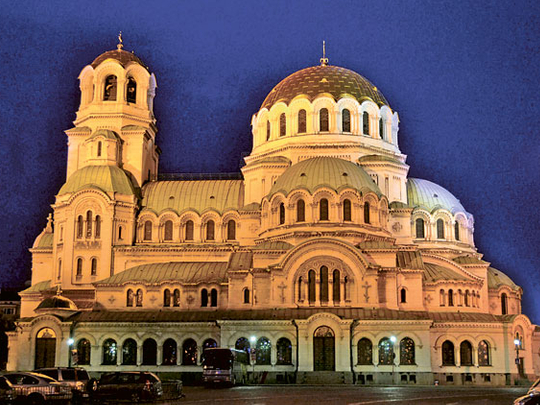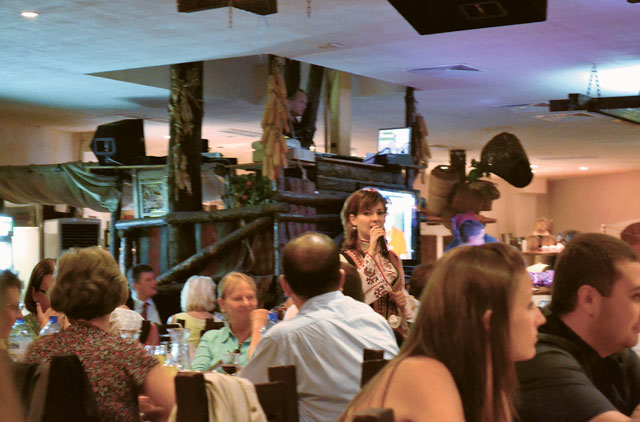
Walking down the streets of Sofia is a bit like entering a time warp. The contemporary architecture of government buildings and public parks is starkly set off with pieces of walls and boulders that were laid by men thousands of years ago — the Romans built the historical city of Serdica on the ground on which Bulgaria's capital now stands.
Throw a heavy mix of culture into this intertwining of old and new and you have your Sofia experience. Pick up a bicycle or just start walking under the shadow of the linden trees lining the cobbled streets and you will soon lose track of time.
Despite being a capital city, Sofia's pace is steady and relaxed. Our Bulgarian friends tell us this isn't very different from the rest of the country. Apparently, Bulgarians like to enjoy the little things in life. A dinner with family and friends, for example, can often go on for hours, with conversations and laughter being the focus more than eating or drinking. Every little aspect of life in Bulgaria — a thread bracelet or even a street dog — has a story behind it. A cultural perspective or folklore is ready to entertain you at every corner, if you want to listen.
Bulgaria's story goes back to Thracian times, some 3,000 years before Christ. Over the millennia, it saw the rise and fall of the Romans, the Ottomans and, not so long ago, the USSR. And these imprints of man's wars, his conquests and defeats, can be seen even today in the twisting roads in Sofia Central. The country's name itself probably comes from the ancient race of the Bulgars, who inhabited the land thousands of years ago.
Cuisine
But history is just one aspect of the city — from a rich culture to a surprisingly diverse cuisine, Bulgaria can grow on you fairly quickly.
Having travelled from the Arabian Gulf on Qatar Airways' inaugural flight to Sofia, it was a pleasant surprise when we were served with what clearly looked like vine and cabbage leaves as appetisers. Wasn't "Waraq Inab" part of Arabian cuisine?
"Everything we like about people, we make it ours," we were told by our host Darin Stoykov. And clearly that appears to be the case. From Turkish architecture and Arabian food to Greek salads and Italian desserts, the country seems to have truly welcomed every influence that it loved.
But the cuisine is also interestingly unique in taste thanks to its dairy products, especially the world-famous Bulgarian yoghurt and white brine cheese (also known as feta), which are an integral part of Bulgarian food.
A classic example is the Shopska salad, a popular appetiser. It is a scrumptious mix of fresh tomatoes, cucumbers, olives and some onions topped with a generous helping of shredded Bulgarian white cheese. While that might sound like just another Greek salad, the taste could not be more unique, which makes it one of the things you must try if you visit the country.
Bulgaria also has one of the world's largest Eastern Orthodox cathedrals — the St Alexander Nevsky cathedral. It is the home of the Cyrillic script and there are several monasteries and national heritage sites that provide an interesting insight into religious history, culture and heritage.
The country's eastern border is all blue — the Black Sea gives Bulgaria a 378-kilometre-long coastline. That, along with the mountainous terrain in other parts of the country, allows visitors an interesting mix of adventure and sea tourism.
But the one thing that you just cannot leave Bulgaria without is a small bottle of rose otto or attar. The country is famous for its rose oil production, providing almost 70 per cent of global supplies. A single gram of oil contains the essence from more than 2,000 rose petals, making it a popular choice as a base note for well-known perfume brands across the world, and just the perfect takeaway from the land of the Bulgars.
Five things to do in Sofia
1. The Free Sofia Tour: While in Sofia, a good way to discover the city would be the Free Sofia Tour, rated by Lonely Planet travellers as the best tour you could take. A volunteer-driven, non-profit organisation, the Free Sofia Tour started when a group of young Bulgarians decided to come together and introduce their capital city to the rest of the world.
Gradually, other young people started joining in, and the organisation now has around 12 volunteers who give a free walking tour of the city, twice a day.
"We love the city and want to share it with people," said Krassimir Yanko, one of the volunteers.
Even though the volunteers cover all the main sites in Sofia during the tour, Yanko admits that it is anything but a formal, scripted process.
"We don't repeat the same script like other tour guides, we just talk to the people who show up at the Palace of Justice and start talking to them about whatever the want to know about the city."
Log on to www.freesofiatour.com for more details.
2. Pod Lipite: One of the iconic restaurants in Sofia, this eatery has an interesting history attached to it. More than 80 years ago, the writers and poets of Sofia went hunting in the woods nearby and on their return stopped at the first landmark of the city — a linden tree and the small house next to it. It was under that very tree that the wordsmiths of old sat and shared their passion for writing, while the day's hunt was cooked by the house's gracious host. These weekly get-togethers gradually became more regular and led to the creation of this restaurant, aptly called "Pod Lipite" or "under the linden trees".
Log on to www.podlipitebg.com for more details.
3. St Alexander Nevsky Cathedral: One of the largest Eastern Orthodox cathedrals in the world, the structure is beautifully built and is believed to hold the largest collection of Orthodox icons in Europe.
4. The Happy Village: If you are in the mood for song and dance, Happy Village would be the restaurant to stop at. With performances from local artists, singers and dance troupes, the food is good and the ambience is lively. Don't be surprised if the entire restaurant stands up and starts dancing along with the performers.
5. Travel to neighbouring cities: If you are in the mood to unwind, the spa capital of the country — Sandanski — is just a few hours' drive away. With a rich resource of mineral water springs, Sandanski is your best bet for an enjoyable spa experience.
Sofia, Bulgaria
Qatar Airways flies four times a week to Sofia, with a stopover at Bucharest, Romania.
FLY... Qatar Airways
Qatar Airways flies four times a week to Sofia, with a stopover at Bucharest, Romania, from Dh1,190 one way. Or try Turkish Airlines from Dubai (via Istanbul) to Sofia for Dh2,970.
— Information courtesy the Holiday Lounge by Dnata Ph: 04 3492886.








